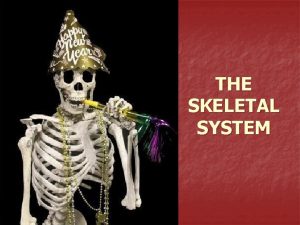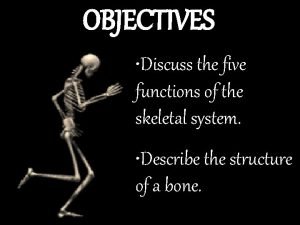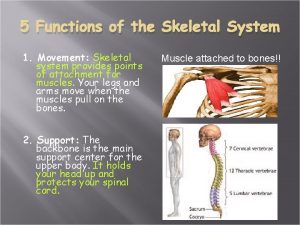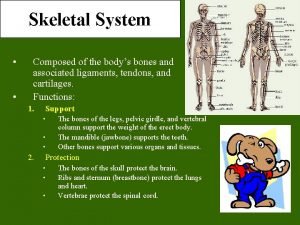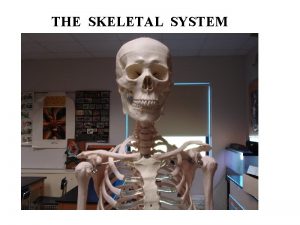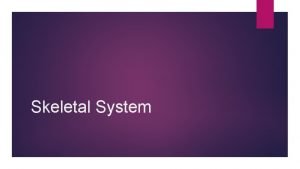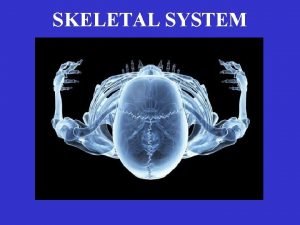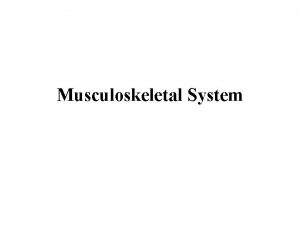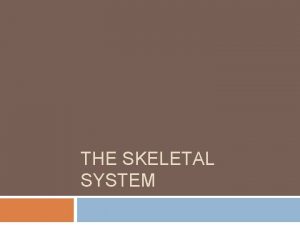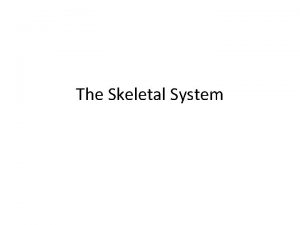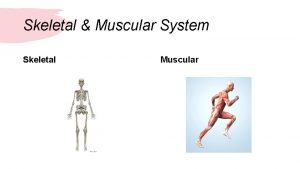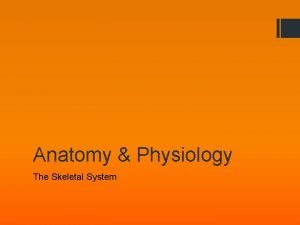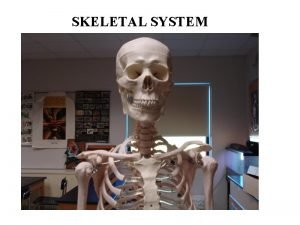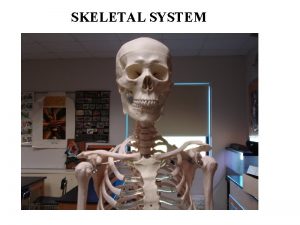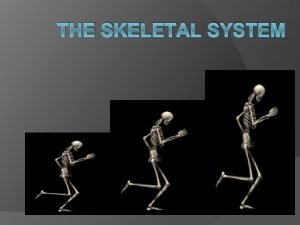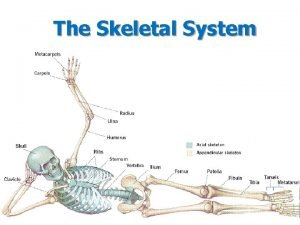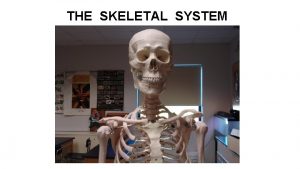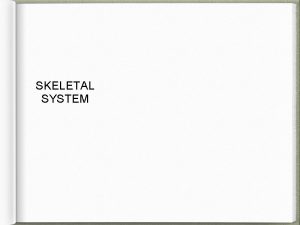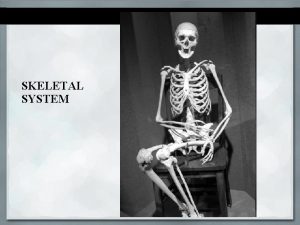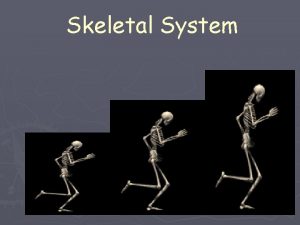SKELETAL SYSTEM The Functions of Skeletal System v

























- Slides: 25

SKELETAL SYSTEM The Functions of Skeletal System v Protect v. Act as Levers v Serve as Attachments for muscles

The Skeletal System Continued v There are 206 bones in the human body. v Examples of bones are: • Skull – Head • Jaw Bone – Mandible • Clavicle – Collar Bone • Scapula – Shoulder Blade • Humerus – Upper Arm • Radius/Ulna – Lower Arm • Carpals – Wrist

Bones of the Skeletal System Continued: • Sternum – Breast Bone • Ribs (24? ) • Vertebrae – Spinal Cord • Ilium – Hip Bone • Femur – Thigh Bone • Patella – Knee Cap • Tibia – Shin Bone • Fibula • Tarsals – Ankle/Foot

I found the femur

Facts Concerning the Skeletal System v Inside the bone there is a hallow space filled with a sponge like substance know as Marrow where Red Blood Cells are produced. v Bursa Sacs are located around the joints of the body and secrete Synovia Fluid which Lubricates the movements of the bones. v Ligaments serve as connecting tissue holding bones together. v Tendons hold muscles to bones. v. Cartilage


Joints of the Human Body v Ball and Socket v Pivot v Hinge v Gliding v Fused

Problems Concerning the Skeletal System v Bursitis: Inflammation of the bursa Sacs. v. Arthritis: Inflammation of the Joints.


NERO-MUSCULAR SYSTEM v The functions of muscles: • Provides force on the bones • Acts as a auxiliary pump for the Heart • Overcomes the forces of gravity v The “All or None Law” of muscle physiology: If the stimulus reaches Threshold response (no matter how Strong or weak) then the whole muscle will contract and if it doesn’t then none of the muscle will contract.

Examples of Muscles • Frontalis • Temporalis • Pectoralis Major • Deltoid • Biceps Brachi • Triceps • Rectus Abdominis • Rectus Femoris • Tibialis Anterior




THE AUTONOMIC NERVOUS SYSTEM Heart Beat Respiration Digestion

THE NERVOUS SYSTEM § The Central Nervous System is made up of the brain and spinal cord. § Sensory Nerves take messages to the brain. § Motor Nerves take messages away from the brain. § Association Nerve Cells are specialized nerve cells which intercept and direct a reflex motor response in order to protect the body.


The Parts of the Brain § Cerebrum contains centers for memory, intelligence, emotions, speech, hearing, and vision. § Cerebellum contains centers that controls muscle movement. § Mid-Brain and pons serve primarily as connecting stations for the brain. § Medulla Oblongata contains centers for heart beat and respiration.

Human Brain

The Nerve Cell Function § Axon takes message from one nerve to another. § Dendrites receives the messages from an axon from another cell. § Nota Bene: The axon and dendrite do not touch there is a gap between them. this gap is a bridged by a synapse facilitated by a chemical known as Acetyicholine which is active in the transmission of nerve impulses.

The Nerve Cell

DISORDERS OF THE NERVOUS SYSTEM Julius Caesar § EPILEPSY: Grand Petite Mild believed to be caused by pressure on the brain. Dwight D. Eisenhower Stroke or Apoplexy: Oxygen is cut off to the brain. Brain damage may resul as well as loss of certain voluntary muscle functions. Woodrow Wilson

Dr. Jonas Salk Franklin D. Roosevelt Polio Myelitis: A Virus which caused Nerve cell damage. Two doctors Invented vaccines to immunize people from Polio Dr. Salk via injection and Dr. Sabin developed an oral vaccine. Dr. Albert Sabin

Multiple Sclerosis A disease marked by patches of hardened tissue in the brain or spinal cord resulting in partial or complete paralysis and muscular twitching. Parkinson’s Disease (PD) Michael J. Fox A degenerative disorder of the central nervous system that often impairs the suffers motor skills, speech, and functions i. e. muscle rigidity, tremor, slowing of and/or loss of physical movement. Janet W. Reno

Lou Gehrig’s Disease Amyotrophic Lateral Sclerosis (ALS) A progressive neuromuscular disease that weakens and destroys motor neurons that connect the brain with the skeletal muscles. Patients become paralyzed and often require ventilation. Loss of respiratory function is ultimately the cause of death.
 Five functions of the skeletal system
Five functions of the skeletal system What are the five functions of the skeletal system?
What are the five functions of the skeletal system? 5 functions of a skeleton
5 functions of a skeleton Arms movement
Arms movement 5 functions of skeletal system
5 functions of skeletal system Functions of the skeletal system
Functions of the skeletal system Function of muscular tissue
Function of muscular tissue Hình ảnh bộ gõ cơ thể búng tay
Hình ảnh bộ gõ cơ thể búng tay Frameset trong html5
Frameset trong html5 Bổ thể
Bổ thể Tỉ lệ cơ thể trẻ em
Tỉ lệ cơ thể trẻ em Voi kéo gỗ như thế nào
Voi kéo gỗ như thế nào Chụp tư thế worms-breton
Chụp tư thế worms-breton Chúa yêu trần thế alleluia
Chúa yêu trần thế alleluia Các môn thể thao bắt đầu bằng tiếng bóng
Các môn thể thao bắt đầu bằng tiếng bóng Thế nào là hệ số cao nhất
Thế nào là hệ số cao nhất Các châu lục và đại dương trên thế giới
Các châu lục và đại dương trên thế giới Cong thức tính động năng
Cong thức tính động năng Trời xanh đây là của chúng ta thể thơ
Trời xanh đây là của chúng ta thể thơ Mật thư anh em như thể tay chân
Mật thư anh em như thể tay chân 101012 bằng
101012 bằng độ dài liên kết
độ dài liên kết Các châu lục và đại dương trên thế giới
Các châu lục và đại dương trên thế giới Thơ thất ngôn tứ tuyệt đường luật
Thơ thất ngôn tứ tuyệt đường luật Quá trình desamine hóa có thể tạo ra
Quá trình desamine hóa có thể tạo ra Một số thể thơ truyền thống
Một số thể thơ truyền thống
